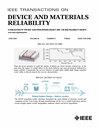基于28纳米CMOS技术的环形振荡器bti驱动退化建模分析
IF 2.5
3区 工程技术
Q2 ENGINEERING, ELECTRICAL & ELECTRONIC
IEEE Transactions on Device and Materials Reliability
Pub Date : 2023-06-21
DOI:10.1109/TDMR.2023.3288380
引用次数: 0
摘要
随着可靠性边际的收紧,产品级老化分析正逐渐获得动力,并将成为现代设计流程中不可或缺的一部分。越来越多的重点放在基于物理的紧凑模型的发展负责晶体管退化的现象和他们集成到EDA环境。先进技术的商业工艺设计套件(pdk)也开始包括晶体管退化的紧凑模型以及专用的可靠性仿真框架。在这项工作中,我们在单个设备以及环形振荡器(RO)的广泛测量数据的帮助下,对一个这样的商业PDK中的紧凑型老化模型进行了全面研究。然后,我们对所测bti应力器件的完整$I_{d}$ - $V_{gs}$拟合进行模型参数位移提取,以深入了解铸造厂采用的建模过程。最后,我们使用由此提取的参数来研究时间-0和与时间相关的设备间可变性对RO退化的影响。本文章由计算机程序翻译,如有差异,请以英文原文为准。
Modeling Analysis of BTI-Driven Degradation of a Ring Oscillator Designed in a 28-nm CMOS Technology
With tightening reliability margins, product-level aging analysis is gradually gaining impetus and is set to become an integral part of the modern design flow. Increased emphasis is placed on the development of physics-based compact models for the phenomena responsible for transistor degradation and their integration into EDA environments. Commercial Process Design Kits (PDKs) of advanced technologies have also started to include compact models for transistor degradation along with a dedicated reliability simulation framework. In this work, we present a comprehensive study of the compact aging models in one such commercial PDK, with the help of extensive measurement data from individual devices as well as Ring Oscillators (RO). Then, we perform our own extraction of model parameter shifts from full
$I_{d}$
-
$V_{gs}$
fitting of the measured BTI-stressed devices to gain insight into the modeling procedure adopted by the foundry. We finally use the parameters extracted thusly to investigate the impact of the time-0 and the time-dependent device-to-device variability on RO degradation.
求助全文
通过发布文献求助,成功后即可免费获取论文全文。
去求助
来源期刊

IEEE Transactions on Device and Materials Reliability
工程技术-工程:电子与电气
CiteScore
4.80
自引率
5.00%
发文量
71
审稿时长
6-12 weeks
期刊介绍:
The scope of the publication includes, but is not limited to Reliability of: Devices, Materials, Processes, Interfaces, Integrated Microsystems (including MEMS & Sensors), Transistors, Technology (CMOS, BiCMOS, etc.), Integrated Circuits (IC, SSI, MSI, LSI, ULSI, ELSI, etc.), Thin Film Transistor Applications. The measurement and understanding of the reliability of such entities at each phase, from the concept stage through research and development and into manufacturing scale-up, provides the overall database on the reliability of the devices, materials, processes, package and other necessities for the successful introduction of a product to market. This reliability database is the foundation for a quality product, which meets customer expectation. A product so developed has high reliability. High quality will be achieved because product weaknesses will have been found (root cause analysis) and designed out of the final product. This process of ever increasing reliability and quality will result in a superior product. In the end, reliability and quality are not one thing; but in a sense everything, which can be or has to be done to guarantee that the product successfully performs in the field under customer conditions. Our goal is to capture these advances. An additional objective is to focus cross fertilized communication in the state of the art of reliability of electronic materials and devices and provide fundamental understanding of basic phenomena that affect reliability. In addition, the publication is a forum for interdisciplinary studies on reliability. An overall goal is to provide leading edge/state of the art information, which is critically relevant to the creation of reliable products.
 求助内容:
求助内容: 应助结果提醒方式:
应助结果提醒方式:


